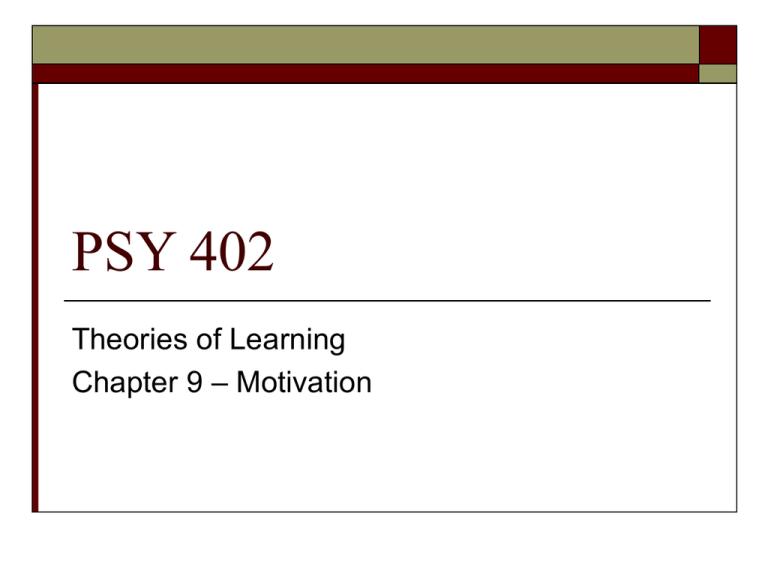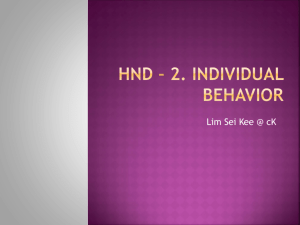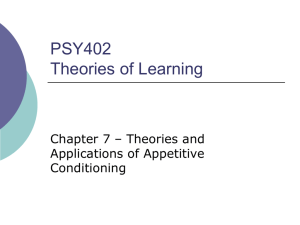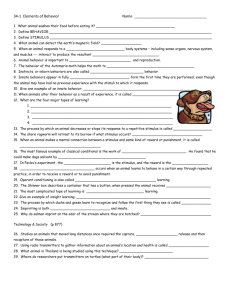Chap9b
advertisement

PSY 402 Theories of Learning Chapter 9 – Motivation Hull’s Response Spence modified Hull’s drive theory to include findings of incentive motivation. K was added to account for incentive. Behavior strength = D x H x K Drive is innate and internal, incentive is learned and external. Drive pushes behavior, incentive pulls it. Fractional Anticipatory Goal Reactions The idea of a motive seemed mentalistic – how can a behavioristic theory explain expectations and goals? rG-sG mechanism -- Intermediate states between the initial behavior and the goal are chained together by associations (classical conditioning). RG = goal reaction or response (capital R) rG = association of goal box with goal reaction (small r) sG = similarity between start and goal box evoked rG & salivation, which becomes a stimulus motivating response 9.10 How a “fractional anticipatory goal reaction” causes incentive motivation in the runway sG also becomes associated with the start via classical conditioning Frustration Amsel extended the idea of rG-sG mechanisms to negative contrast (explained by the mentalistic concept of frustration). Expectation of a big reward (RG) but receipt of a small reward results in frustration (RF). The size of RF is the discrepancy between previous rewards and the current reward size. rF also becomes generalized to the goal box and start box to demotivate (reduce responding). 9.11 The effect of frustration in the double runway Faster running means more feet per sec Paradoxical Reward Effects In some situations, reward seems to weaken, not strengthen responding. Negative contrast is one example – a perfectly good reward fails to motivate responding. Magnitude of reinforcement effect -reinforcement with a large reward leads to faster extinction than reinforcement with a small one. Overlearning extinction effect – many rewarded trials extinguish faster than a few rewarded trials. Effects on Intrinsic Motivation Rewarding a behavior that was previously performed for intrinsic reasons (internally motivated) leads to reduced behavior. Preschoolers expecting reward drew less. “Punished by reward” phenomenon – some suggest that rewarding creative activity may hurt it. Reward effects are relative and complex (affected by many factors). 9.12 Trouble for the future of American sports? Skilled Use of Reward Performance decreases in situations where: Rewards were tangible (money) Announced ahead of time Given in a way that was not dependent on performance. Reward is perceived as a way to manipulate or control someone. Performance increases when verbal praise is given, when reward is unexpected, relevant. Persistence of Behavior Partial reinforcement extinction effect (PREE) – behavior is more resistant to extinction when it is reinforcement intermittently. Continuous reinforcement – acquired faster and extinguished faster. Partial reinforcement (50%, VR-2) – acquired slower and extinguished slower. Persistence generalizes to other tasks – learned industriousness. 9.13 The Partial Reinforcement Extinction Effect (PREE) Theories about PREE Amsel’s frustration theory -- animals learn to respond in the presence of frustration. Frustration attaches to the stimulus (sF) after an unrewarded trial, then responding to it is rewarded. Capaldi’s sequential theory – the rat has a memory of responding after a non-reinforced trial. It responds because the stimulus is familiar. 9.14 Response speed New Understanding of Extinction Extinction involves new learning that is dependent on context. Research on PREE suggests also that: Extinction occurs when generalization from acquisition trials stops (generalization decrement) Frustration occurs and reduces motivation when an expected reward does not occur, but is not needed to explain PREE. Problems with rG-sG If classically conditioned associations motivate behavior, they should correlate with responding, but they don’t. Concurrent measurement studies showed little correlation between salivation and responding rewarded by food. In studies of shock avoidance, fear (rE) showed little correlation with vigor of avoidance. Central states not peripheral should be measured. Transfer of Control Increasing or decreasing the intensity of an internal state (expectancy) should affect behavior. Pavlovian-Instrumental Transfer. An instrumental behavior and a CS are both learned separately. When paired with each other, behavior should increase. Dogs in shuttle box showed this effect. 9.15 A transfer-of-control experiment Dogs jump across the shuttle box to avoid shock Effects of Pavlovian CS’s Some of the effects of Pavlovian inhibitors on instrumental responding occur because of evoked fear. Rat freezing due to fear interferes with avoidance. Excitatory Pavlovian CS’s can activate an entire system, not just a specific response. In other contexts, the effect of the CS is specific to the type of reward (food vs water). The explanation for this is unclear. 9.16 Pavlovian-instrumental transfer Two behaviors, two types of reward. Practical Applications Classical conditioning (CS’s) are always present and affect instrumental behavior. Obsessive checking behavior is worse when anxiety is heightened by a CS, better when less fear is evoked. CS’s associated with a drug increase the motivation for drug-taking behavior. CS’s evoke a system of responses one of which may be instrumental behavior. 9.17 One effect of a CS is to excite or inhibit a motivational state Opponent-Process Theory Emotional after-reaction – an emotional stimulus creates an initial response that is followed by adaptation, then opposite response. With repeated exposure to the stimulus, the pattern changes. The primary affective response (a-process) habituates. The after-reaction (b-process) strengthens 9.18 The standard pattern of affective dynamics 9.19 Changes in the standard pattern of affective dynamics Imprinting Baby ducks initially respond only to moving stimuli, but with repeated exposure will be comforted by a stationary stimulus. They follow it around due to sign tracking. The imprinted stimulus (train) can calm an upset duck but causes distress when removed, even if the duck is already calm. The distress is the b-process in attachment. 9.20 Distress-calling in ducklings (Part 1) 9.20 Distress-calling in ducklings (Part 2) Effects of Repeated Exposure Ducks become more attached to an imprinted stimulus after repeated exposures. Exposures must be massed (spaced close together in time). A single long exposure produces a distress-calling after-reaction. This is contrary to other classical conditioning situations, where massed exposure is worse. 9.21 Distress-calling in ducklings after 30-second exposures to a moving, stuffed duck (Part 1) 9.21 Distress-calling in ducklings after 30-second exposures to a moving, stuffed duck (Part 2) This is why binging can create addiction Drug Addictions Withdrawal symptoms seem to be an opponent-process elicited by a CS associated with the drug (S*). The CR is the b-process and it offsets the body’s response to the drug itself. The opponent process appears to be learned, not innate. It is problematic for the learning explanation that the b-process increases with massed exposure.






